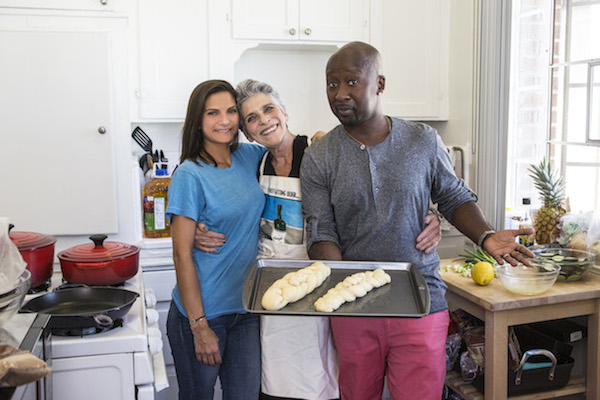Cultural anthropologists call it ‘going native’. You find yourself in the field as a participant observer of your host culture and before you know it, the lines blur. You fall in love with this culture, you want to transition and be part of it. You adopt language, mannerisms, dress, philosophical outlook and eventually you consider yourself one of them.
I was doing cultural anthropological fieldwork in New York in 2004 and I went native. In my case, the order of affairs was reversed. I had already fallen in love with Judaism, wanting to convert. So I adapted my graduate project to suit my needs by travelling to one of the epicenters of Diaspora Jewish life. I moved to Brooklyn, davened at a shul in Park Slope, hung out with independent minyanim such as Kehillat Hadar on the Upper West Side and meanwhile interviewed Jews for my fieldwork while at the same time studying towards conversion. And in order to facilitate entry into the community for the sake of my fieldwork, I died my blonde tresses an unassuming dark brown.
Now, I didn’t hide my identity. All the people in my new community knew I was converting. But when interviewing Jewish professionals and activists on the topic of my research project (Progressive Zionism), I decided that toning down my glaringly Nordic looks would build trust and ease communication. I was practically a Jew already, spoke the lingo, was familiar with the cultural tropes and dreaded not being able to have meaningful interviews because people deemed me too much of an outsider.
I’m not sure it helped—or that it mattered. People spoke to me regardless and in some other cases, my non-Jewish ancestry was easily uncovered. I will not forget that priceless moment, shortly after my conversion, that I showed up at a morning minyan in your average Conservative shul, proudly donning tallit and tefillin. As I was wearing a kippah, tallit, tefillin and a magen david necklace, a woman remarked, ‘Are you Jewish? You don’t look Jewish’.
More than a decade later, I can proudly say that I don’t look ‘Jewish’. I’m Jewish in every fiber of my being (so much so that I trained as a rabbi and serve a congregation) but since that day I’ve decided to pass on passing and wear my blonde tresses (it’s a pixie cut at the moment) with confidence.
I’ve come to embrace the understanding that identity is complex and fluid, a notion I had intellectual understanding of but that still felt daunting internalizing, especially in a world of identity politics often wary of what we anthropologists term ‘category confusion’. When X doesn’t easily slot into Z, it can be unsettling. We all want to belong and belonging is defined by boundaries. When people transition across those boundaries, there often needs to be a ritual to validate this crossing. In Judaism, it’s known as a process of conversion. But it also shows dignity and maturity when we can accept our personal history and the unique aspects of our identity that make us, well, us, even if that makes us a little different to the mainstream of our (adopted) communities.
I’ve been far happier in myself and my Judaism since I decided to pass on passing. The wall of my synagogue office is decorated with my framed Ordination Certificate as well as a Victorian-age picture of a paternal ancestor who was one of my many ancestors who went into Protestant ministry. Hanging that picture wasn’t only nostalgic, it was an intentional, strategic choice to invite congregants and visitors into a conversation about identity and what it means to be Jewish. Invariably, people ask about the picture and I explain who he was. Many a Jew-by-Choice (or those considering conversion) has been put at ease and many a Jew-by-Birth have had their thinking challenged in a positive way by this.
There is, of course, some potential baggage that comes with being a convert, even a convert-rabbi. Lines of privilege and exclusion intersect at odd angles and it takes some effort to balance these different aspects. Yes, I can blend into wider society in a way that more stereotypically ‘Jewish-looking’ Jews cannot. At the same time, by virtue of being a community leader and a vocal advocate and activist for my Jewish community, I expose myself to risks and dangers that many Jews are not exposed to. And truth to be told, I’m so bound up with Judaism that adopting another (even former) identity would feel painfully artificial. There is no escape clause.
Experience has shown me that ‘going native’ is not as simple as appropriating another culture and another’s narrative of oppression. It’s not as simple as fetishising ‘ethnic chic’. I make a delicious matzoh ball chicken soup, but it’s my take on it. I have a beautiful inflection of Hebrew, but it’s inspired by the gutturals of my own native tongue. And at the Pesach Seder, I embrace my own understanding of what it is to say that ‘my father was a wandering Aramean’.
I’m not trying to pass any more. Thank God, I have come to love my Judaism on its own terms. I’m content to be a boundary-crosser, as my Hebrew name behooves me to be. As a daughter of Abraham and Sarah, I proudly follow in the footsteps of the best boundary-crossers of all, ha’Ivri, the first Hebrew couple. Blonde hair and all.







